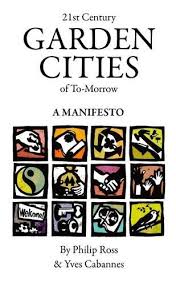21st Century Garden Cities of To-Morrow. A Manifesto

In 1898, Garden Cities of To-morrow – the peaceful path to reform was published. The movement that book sparked led to the first-ever Garden City, Letchworth (UK). More recently, one of Letchworth’s previous mayors, Philip Ross, joined the urban planner/professor Yves Cabannes later to write this little book, a 21st-century update of the 1898 one.
21st Century Garden Cities of To-Morrow lays out the 12 principles that, in the authors’ view and in various combinations, constitute a Garden City. People rather than landscapes are at the core of these rural–urban hybrids.
1. Residents are citizens. Ross and Cabannes promote a model of active citizenship that is more about empowered participation and a sense of belonging than legal status.
2. The Garden City owns itself. In effect, such a city is its own landlord. Examples are community land trusts and cooperative land banks.
3. The Garden City is energy efficient and carbon neutral. The right to clean air is respected through measures such as green transport.
4. Provide access to land for living and working to all. Land must be used inclusively for housing, business, recreation and agriculture (as in Havana, where the US trade embargo and loss of Soviet food imports led to an explosion of urban agriculture).
5. Fair Trade principles are practised. This is an international means of sharing prosperity (the principle below).
6. Prosperity is shared. Inequality is reduced and wealth redistributed through participatory budgeting, where the population decides on what happens with their city’s money.
7. All citizens are equal, all citizens are different. All residents can contribute and be rewarded.
8. Fair representation and direct democracy. Forms of governance will vary depending on context (such as street committees in Venezuela), but the principle of genuine participation should always be observed.
9. Garden Cities are produced through participatory planning and design methods. Inclusive public spaces are designed by citizens and not only planners
10. A City of Rights that builds and defends the Right to the City. Individual and collective rights are protected, as well as the Right to the City, which is both individual and collective.
11. Knowledge is held in common, shared and enhanced. Cooperation and innovation are prized.
12. Wealth and harmony measured by happiness. While recognizing how difficult it is to measure happiness, the authors urge moving beyond a focus on material wealth.
These principles are presented as a harmonious approach to urban design and community relations that can apply to existing cities as well as to new towns.
Further reading:
Bhan, Gautam (2009), “ ‘This is no longer the city I once knew’. Evictions, the urban poor and the right to the city in millennial Delhi”, Environment and Urbanization Vol 21, No 1, pages 127–142, available at http://eau.sagepub.com/content/21/1/127.abstract.
Conaty, Pat and Martin Large (editors) (2013), Commons sense: Co-operative place making and the capturing of land value for 21st century Garden Cities, Co-operatives UK, 96 pages, available at http://www.uk.coop/resources/commons-sense.
Moskow, Angela (1999), “Havana’s self-provision gardens”, Environment and Urbanization Vol 11, No 1, pages 127–134, available at http://eau.sagepub.com/content/11/2/127.abstract.
Book note prepared by Christine Ro
Search the Book notes database
Our Book notes database contains details and summaries of all the publications included in Book notes since 1993 - with details on how to obtain/download.
Use the search form above, or visit the Book notes landing page for more options and latest content.
For a searchable database for papers in Environment and Urbanization, go to http://eau.sagepub.com/

